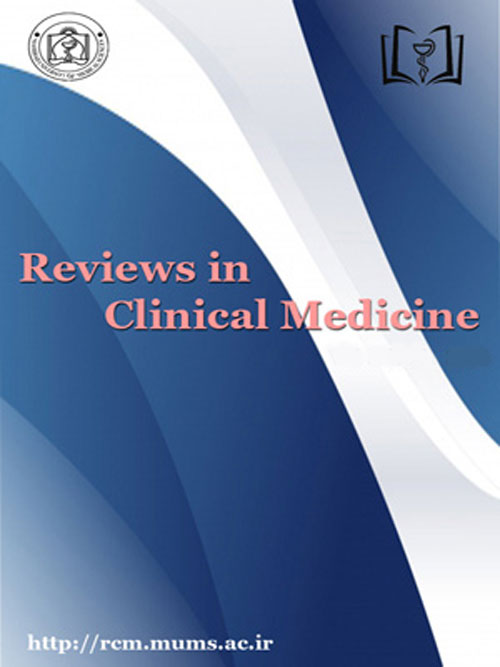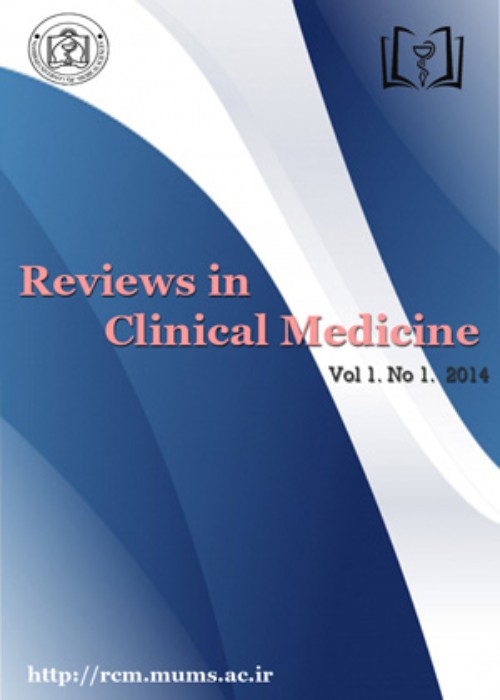فهرست مطالب

Reviews in Clinical Medicine
Volume:4 Issue: 4, Autumn 2017
- تاریخ انتشار: 1396/09/18
- تعداد عناوین: 8
-
Pages 143-151IntroductionNurses play a key role in the process of organ donation and transplantation, and previous studies have widely addressed the level of knowledge and attitude of intensive care unit (ICU) nurses in this regard. Considering the direct correlation between the positive attitude of the healthcare team, especially nurses, and the level of consent on organ donation, knowledge and attitude of nurses are important factors that have been assessed in several studies. However, no definite conclusions have been drawn in this regard. The present study aimed to evaluate the knowledge and attitude of ICU nurses toward organ donation and the related factors.MethodsA systematic review was conducted via searching in databases such as ProQuest, Medscape, MedlinePlus, MagIran, PubMed, and ScienceDirect to identify the articles published during 1990-2015 using keywords such as knowledge, attitude, organ donation, and nurses.ResultAwareness and knowledge are the main determinants of attitude in nurses, which should be applied in order to foster positive attitudes in the process of organ donation. Furthermore, extensive clinical knowledge should be acquired on organ donation and communication skills by ICU nurses through proper training programs.ConclusionAccording to the results, using standard guidelines or scheduled training programs in nursing schools could improve the level of knowledge in nurses, which in turn enhances nursing performance. In addition, our findings indicated that positive attitude and knowledge of nurses could largely infleunce the viewpoint of families toward organ donation.Keywords: Knowledge, Nurses, Organ Donation
-
Pages 152-159IntroductionHepatitis E infection is caused by the hepatitis E virus (HEV) and is a self-limiting disease with moderate-to-high prevalence in various regions. Considering that HEV is endemic in Iran, the present study aimed to systematically review the prevalence of HEV in Iran.MethodsThis systematic review was performed in May 2016 to investigate the prevalence of Hepatitis E infection in Iran via searching in databases such as PubMed, Scopus, and IranMedex using the following approach: (((Hepatitis E OR HEV)) AND (epidemiology OR frequency OR prevalence)) AND Iran. After collecting the proper documents, the required data were extracted and described.ResultIn total, 24 relevant articles with 12,555 study populations were collected in this study. The results of the review indicated that the prevalence of HEV is relatively high in the Iranian population. In the reviewed literature, the prevalence of HEV varied from 2.3% to more than 40%.ConclusionAccording to the results, the prevalence of HEV in Iran is similar to the rate reported in the other developing countries. Therefore, it is recommended that routine tests be conducted for the diagnosis of hepatitis E, especially in the suspected cases of acute non-A, non-B, and non-C hepatitis.Keywords: Hepatitis E virus_Non-A hepatitis_Non-B hepatitis
-
Pages 160-164IntroductionUltrasonographic assessment of the kidney size in newborns is essential to the diagnosis of renal diseases during the neonatal period. According to the literature, altered renal dimensions may lead to changes in the kidney echotexture in certain renal pathologies. This systematic review aimed to evaluate the renal dimensions in premature and term neonates.MethodsThis systematic review was conducted to identify the English articles on the renal dimensions of children and premature/term neonates via searching in databases such as PubMed, Google Scholar, and Scopus. In total, 74 studies were retrieved from the electronic databases. After reviewing the titles and abstracts, 10 articles that were in line with the study objectives were selected in full text and evaluated.ResultThe studies on the renal dimensions of newborns had been performed on various populations. Some studies had compared kidney diameters with the body weight and length of the neonates within the first days of birth, while some others had compared the gestational age of neonates with their kidney size. However, no conclusive results were proposed. In addition, several studies were found on kidney size during the fetal period and childhood, while limited investigation was available regarding the neonatal period. In the present study, we analyzed the correlations between the renal dimensions of neonates and their gestational age, length, weight, and body surface area by reviewing the current literature.ConclusionAlthough renal volume is considered to be the most precise index of the kidney size, renal length is evidently the most practical indicator of renal dimensions, which is correlated with the anthropometric indices and gestational age of neonates.Keywords: Infant, Newborn, Ultrasonography
-
Pages 165-168Sneddon syndrome (SS) is characterized by chronic, progressive arteriopathy, which causes ischemic stroke and skin lesions. It seems that thrombotic or embolic processes in the vessels may be involved in the pathology of this syndrome. Neurological symptoms always occur due to the ischemic events of the cerebrovascular system, and the associated cutaneous manifestations include deep blue skin lesions with irregular margins, known as livedo reticularis and livedo racemosa. Despite the ischemic events, hemorrhagic cerebral accidents are unusual in SS. Our case was apparently a normal woman with negative medical history who, despite the normal ischemic cerebral manifestations, initially presented with intracranial hemorrhage, which progressed to new skin lesions (livedo reticularis) after a few days. In the follow-up, the patient was diagnosed with SS.Keywords: Intracranial Hemorrhage, livedo reticularis, Sneddon Syndrome
-
Pages 169-172Uterine atony is the main cause of postpartum hemorrhage (PPH). Uterine compression suture is a common technique to control PPH in caesarean delivery. This article aimed to report a complication of this method for post-delivery atony. A 27-year-old primigravida woman with term pregnancy underwent caesarean delivery and was unresponsive to medical therapy and uterine artery ligation due to uterine atony. Two compression sutures were placed on her uterus. However, after 11 days, the patient underwent surgery again due to severe fever, infection, and a necrotic mass in the uterine cavity. The necrotic mass was we removed during the surgery. Although uterine compression suture is an effective method for the treatment of PPH, we witnessed some side effects in the patient, especially myometrium necrosis.Keywords: Postpartum Hemorrhage, Suture Techniques, Uterine Atony
-
Severe Backache followed by Lumbar PuncturPages 173-175The purpose of this study is to report a case of severe back pain following lumbar puncture (LP), which was associated with an accidental tether cord syndrome (TCS) in MRI. The patient was a 10-year-old boy that was hospitalized in the pediatric ward for severe headache and to rule out meningitis. First, LP was performed for him, but he suffered very severe back pain after LP. Lumbosacral MRI was performed to rule out collection or abscess formation, but the evidence of the TCS was accidentally found; however, it was too unexpected before. In the short term follow up, the symptoms of the patient were completely resolved by using analgesics. It was shown that his pain was as a result of LP. In general, although sometimes severe lower back pain after LP may be overwhelming, if neurologic examination were normal, it is important to assure parents that it would be resolved.Keywords: Complication, Lumbar puncture, Tethered cord
-
Pages 176-179This study aimed to assess the efficacy of magnetic resonance imaging (MRI) and single-photon emission computed tomography (SPECT) in localizing epileptic foci in children with temporal lobe epilepsy (TLE). This prospective study was conducted on 12 patients including five males and seven females aged between 2 and 16 years old with a clinical diagnosis of TLE. All the patients underwent high-resolution MRI and if no abnormality was identified, SPECT was used for further assessment. In all the patients, visual inspection identified unilateral mesial temporal sclerosis, and the patients underwent craniotomy and lesionectomy.
According to the results, eight patients were categorized in class I and two cases were classifies as class II, and all the patients survived. About 25% of the patients showed adequate memory function on the non-operated temporal lobe, and general intelligence quotient increased by 10% in 50% of the patients.
According to the results, in patients with clinically suspected TLE, MRI alone is not able to localize the epileptic foci correctly, and SPECT can be helpful to localize these lesions.Keywords: Child, Temporal lobectomy, Temporal lobe epilepsy -
Pages 180-184Metabolic syndrome and its various manifestations are considered to be a significant health epidemic in the developed and developing countries across the world. Metabolic syndrome is characterized by a series of metabolic abnormalities, such as central adiposity, insulin resistance, hypertension, glucose intolerance, and dyslipidemia. Patients with metabolic syndrome are at a higher risk of major complications, including fatty liver, type II diabetes mellitus, and cardiovascular diseases. Nuclear receptors are the key regulators of gene transcription, as well as several metabolic pathways. Among these receptors, LXRα and β play a major role in the regulation of lipogenesis, cholesterol/glucose homoeostasis, and inflammatory pathways through the induction or repression of target genes. In addition to metabolic homeostasis and diseases, lipogenesis and hypertriglyceridemia are regarded as the most significant adverse effects of liver X receptor (LXR) activation. Given the importance of lipid and carbohydrate metabolism and inflammation in the development of metabolic disorders, the present study aimed to review the impact of LXR signaling on the risk of metabolic syndrome and its phenotypes, with an emphasis on their potential therapeutic applications in the treatment of metabolic syndrome. In general, growing evidence supports the notion that LXRs may represent the potential drug targets for the treatment of metabolic syndrome.Keywords: Liver X Receptor_Metabolic Syndrome_Metabolic Disorder


